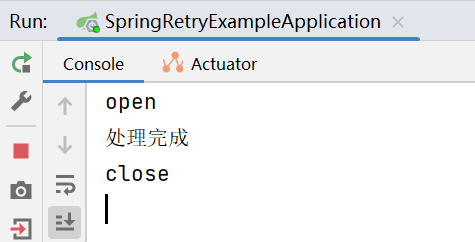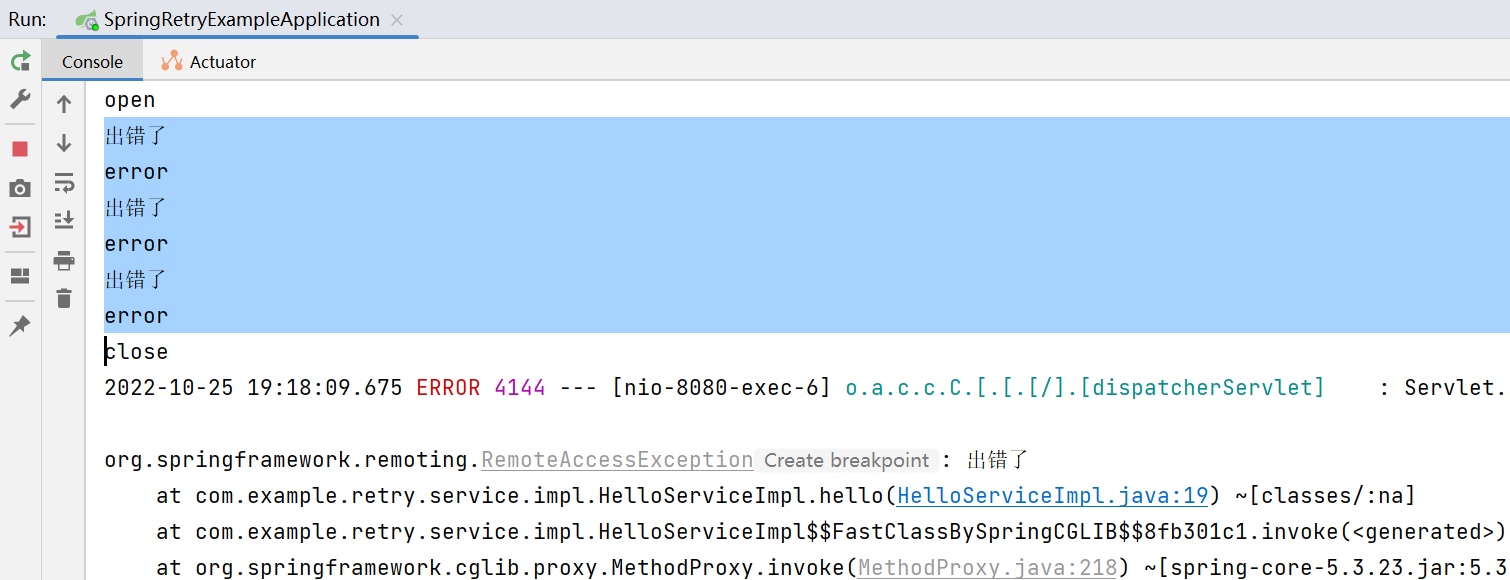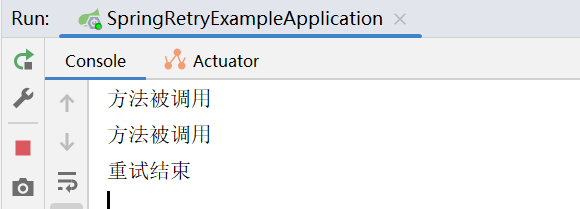您好,登錄后才能下訂單哦!
您好,登錄后才能下訂單哦!
本篇內容介紹了“Spring Retry重試怎么使用”的有關知識,在實際案例的操作過程中,不少人都會遇到這樣的困境,接下來就讓小編帶領大家學習一下如何處理這些情況吧!希望大家仔細閱讀,能夠學有所成!
spring-retry是spring提供的一個重試框架,原本自己實現的重試機制,現在spring幫封裝好提供更加好的編碼體驗。
重試的使用場景比較多,比如調用遠程服務時,由于網絡或者服務端響應慢導致調用超時,此時可以多重試幾次。用定時任務也可以實現重試的效果,但比較麻煩,用Spring Retry的話一個注解搞定所有。話不多說,先看演示。
首先引入依賴
<dependency> <groupId>org.springframework.retry</groupId> <artifactId>spring-retry</artifactId> <version>1.3.4</version> </dependency> <dependency> <groupId>org.aspectj</groupId> <artifactId>aspectjweaver</artifactId> <version>1.9.9.1</version> </dependency>
使用方式有兩種:命令式和聲明式
命令式
/**
* 命令式的方式使用Spring Retry
*/
@GetMapping("/hello")
public String hello(@RequestParam("code") Integer code) throws Throwable {
RetryTemplate retryTemplate = RetryTemplate.builder()
.maxAttempts(3)
.fixedBackoff(1000)
.retryOn(RemoteAccessException.class)
.build();
retryTemplate.registerListener(new MyRetryListener());
String resp = retryTemplate.execute(new RetryCallback<String, Throwable>() {
@Override
public String doWithRetry(RetryContext context) throws Throwable {
return helloService.hello(code);
}
});
return resp;
}定義一個RetryTemplate,然后調用execute方法,可配置項比較多,不一一列舉
真正使用的時候RetryTemplate可以定義成一個Bean,例如:
@Configuration
public class RetryConfig {
@Bean
public RetryTemplate retryTemplate() {
RetryTemplate retryTemplate = RetryTemplate.builder()
.maxAttempts(3)
.fixedBackoff(1000)
.withListener(new MyRetryListener())
.retryOn(RemoteAccessException.class)
.build();
return retryTemplate;
}
}業務代碼:
/**
* 命令式的方式使用Spring Retry
*/
@Override
public String hello(int code) {
if (0 == code) {
System.out.println("出錯了");
throw new RemoteAccessException("出錯了");
}
System.out.println("處理完成");
return "ok";
}


監聽器實現:
package com.example.retry.listener;
import org.springframework.retry.RetryCallback;
import org.springframework.retry.RetryContext;
import org.springframework.retry.RetryListener;
public class MyRetryListener implements RetryListener {
@Override
public <T, E extends Throwable> boolean open(RetryContext context, RetryCallback<T, E> callback) {
System.out.println("open");
return true;
}
@Override
public <T, E extends Throwable> void close(RetryContext context, RetryCallback<T, E> callback, Throwable throwable) {
System.out.println("close");
}
@Override
public <T, E extends Throwable> void onError(RetryContext context, RetryCallback<T, E> callback, Throwable throwable) {
System.out.println("error");
}
}聲明式(注解方式)
/**
* 注解的方式使用Spring Retry
*/
@Retryable(value = Exception.class, maxAttempts = 2, backoff = @Backoff(value = 1000, delay = 2000, multiplier = 0.5))
@Override
public String hi(int code) {
System.out.println("方法被調用");
int a = 1/code;
return "ok";
}
@Recover
public String hiRecover(Exception ex, int code) {
System.out.println("重試結束");
return "asdf";
}這里需要主要的幾點
@EnableRetry(proxyTargetClass = true/false)
@Retryable 修飾的方法必須是public的,而且不能是同一個類中調用
@Recover 修飾的方法簽名必須與@Retryable修飾的方法一樣,除了第一個參數外
/**
* 注解的方式使用Spring Retry
*/
@GetMapping("/hi")
public String hi(@RequestParam("code") Integer code) {
return helloService.hi(code);
}



聲明式
@Configuration
@EnableRetry
public class Application {
}
@Service
class Service {
@Retryable(RemoteAccessException.class)
public void service() {
// ... do something
}
@Recover
public void recover(RemoteAccessException e) {
// ... panic
}
}命令式
RetryTemplate template = RetryTemplate.builder()
.maxAttempts(3)
.fixedBackoff(1000)
.retryOn(RemoteAccessException.class)
.build();
template.execute(ctx -> {
// ... do something
});為了自動重試,Spring Retry 提供了 RetryOperations 重試操作策略
public interface RetryOperations {
<T> T execute(RetryCallback<T> retryCallback) throws Exception;
<T> T execute(RetryCallback<T> retryCallback, RecoveryCallback<T> recoveryCallback)
throws Exception;
<T> T execute(RetryCallback<T> retryCallback, RetryState retryState)
throws Exception, ExhaustedRetryException;
<T> T execute(RetryCallback<T> retryCallback, RecoveryCallback<T> recoveryCallback,
RetryState retryState) throws Exception;
}基本回調是一個簡單的接口,允許插入一些要重試的業務邏輯:
public interface RetryCallback<T> {
T doWithRetry(RetryContext context) throws Throwable;
}回調函數被嘗試,如果失敗(通過拋出異常),它將被重試,直到成功或實現決定中止。
RetryOperations最簡單的通用實現是RetryTemplate
RetryTemplate template = new RetryTemplate();
TimeoutRetryPolicy policy = new TimeoutRetryPolicy();
policy.setTimeout(30000L);
template.setRetryPolicy(policy);
Foo result = template.execute(new RetryCallback<Foo>() {
public Foo doWithRetry(RetryContext context) {
// Do stuff that might fail, e.g. webservice operation
return result;
}
});從Spring Retry 1.3開始,RetryTemplate支持流式配置:
RetryTemplate.builder() .maxAttempts(10) .exponentialBackoff(100, 2, 10000) .retryOn(IOException.class) .traversingCauses() .build(); RetryTemplate.builder() .fixedBackoff(10) .withinMillis(3000) .build(); RetryTemplate.builder() .infiniteRetry() .retryOn(IOException.class) .uniformRandomBackoff(1000, 3000) .build();
當重試耗盡時,RetryOperations可以將控制傳遞給不同的回調:RecoveryCallback。
Foo foo = template.execute(new RetryCallback<Foo>() {
public Foo doWithRetry(RetryContext context) {
// business logic here
},
new RecoveryCallback<Foo>() {
Foo recover(RetryContext context) throws Exception {
// recover logic here
}
});public interface RetryListener {
void open(RetryContext context, RetryCallback<T> callback);
void onSuccess(RetryContext context, T result);
void onError(RetryContext context, RetryCallback<T> callback, Throwable e);
void close(RetryContext context, RetryCallback<T> callback, Throwable e);
}在最簡單的情況下,open和close回調在整個重試之前和之后,onSuccess和onError應用于個別的RetryCallback調用,onSuccess方法在成功調用回調之后被調用。
有時,你希望在每次業務處理發生時都重試一些業務處理。這方面的典型例子是遠程服務調用。Spring Retry提供了一個AOP攔截器,它將方法調用封裝在RetryOperations實例中。RetryOperationsInterceptor執行被攔截的方法,并根據提供的RepeatTemplate中的RetryPolicy在失敗時重試。
你可以在 @Configuration 類上添加一個 @EnableRetry 注解,并且在你想要進行重試的方法(或者類)上添加 @Retryable 注解,還可以指定任意數量的重試監聽器。
@Configuration
@EnableRetry
public class Application {
@Bean
public Service service() {
return new Service();
}
@Bean public RetryListener retryListener1() {
return new RetryListener() {...}
}
@Bean public RetryListener retryListener2() {
return new RetryListener() {...}
}
}
@Service
class Service {
@Retryable(RemoteAccessException.class)
public service() {
// ... do something
}
}可以使用 @Retryable 的屬性類控制 RetryPolicy 和 BackoffPolicy
@Service
class Service {
@Retryable(maxAttempts=12, backoff=@Backoff(delay=100, maxDelay=500))
public service() {
// ... do something
}
}如果希望在重試用盡時采用替代代碼返回,則可以提供恢復方法。方法應該聲明在與@Retryable實例相同的類中,并標記為@Recover。返回類型必須匹配@Retryable方法。恢復方法的參數可以包括拋出的異常和(可選地)傳遞給原始可重試方法的參數(或者它們的部分列表,只要在需要的最后一個之前不省略任何參數)。
@Service
class Service {
@Retryable(RemoteAccessException.class)
public void service(String str1, String str2) {
// ... do something
}
@Recover
public void recover(RemoteAccessException e, String str1, String str2) {
// ... error handling making use of original args if required
}
}若要解決可選擇用于恢復的多個方法之間的沖突,可以顯式指定恢復方法名稱。
@Service
class Service {
@Retryable(recover = "service1Recover", value = RemoteAccessException.class)
public void service1(String str1, String str2) {
// ... do something
}
@Retryable(recover = "service2Recover", value = RemoteAccessException.class)
public void service2(String str1, String str2) {
// ... do something
}
@Recover
public void service1Recover(RemoteAccessException e, String str1, String str2) {
// ... error handling making use of original args if required
}
@Recover
public void service2Recover(RemoteAccessException e, String str1, String str2) {
// ... error handling making use of original args if required
}
}“Spring Retry重試怎么使用”的內容就介紹到這里了,感謝大家的閱讀。如果想了解更多行業相關的知識可以關注億速云網站,小編將為大家輸出更多高質量的實用文章!
免責聲明:本站發布的內容(圖片、視頻和文字)以原創、轉載和分享為主,文章觀點不代表本網站立場,如果涉及侵權請聯系站長郵箱:is@yisu.com進行舉報,并提供相關證據,一經查實,將立刻刪除涉嫌侵權內容。